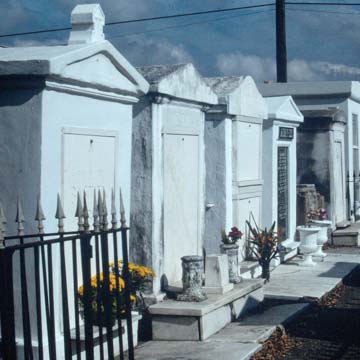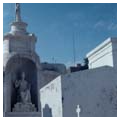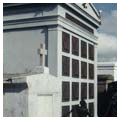Travel writer Edward Henry Durell (pseudonym Henry Didimus), who visited New Orleans in the mid-nineteenth century, described the local practice of burial in his book New Orleans As I Found It (1845): “This method of above ground tomb is adopted from necessity; and burial under ground is never attempted, except . . . for the stranger without friends or the poor without money, and they find an uncertain rest, for the water, with which the soil is always saturated, often forces the coffin and its contents out of its narrow and shallow cell, to rot with no other covering than the arch of heaven.” Established in 1789 just beyond the Vieux Carré’s boundary, St. Louis Cemetery No. 1 is crowded with above-ground tombs, separated only by narrow and tortuous paths. Although in-ground burial was common in New Orleans’s early years, above-ground tombs reflect the city’s French and Spanish heritage and high water table, and their continued use is probably a result of periodic flooding. Most of the tombs are simple rectangles in shape, taller than they are wide, with flat, curved, or gable roofs. Constructed of brick, covered with plaster and then whitewashed, sometimes tinted with color ranging from yellow ochre to red, the tombs were intended for use by generations of a family and usually contained space for more than one casket. When a new burial was necessary, the bones of the current occupant were swept to the rear of the tomb or placed in an ossuary in order to provide room for the new interment. The cemetery, like others in New Orleans, contains a few multistory tombs that accommodate several burial vaults. Called society tombs, these belonged to fraternal or benevolent societies and were intended to ensure the decent burial of their members. The high brick walls enclosing the cemetery contain wall vaults (or fours) on their inner surfaces, with openings covered by brick or marble slabs. These vaults were a less expensive alternative to the freestanding tomb. Sale of the vaults was a source of revenue for the City. Benjamin Henry Latrobe designed the tomb for Governor William C. C. Claiborne (1811), who later was reburied in Metairie Cemetery (OR198). Latrobe and his son Henry are reputedly buried in the ground in the rear in an area, originally outside the cemetery, designated for those who were not Roman Catholic. Jean Etienne Boré, sugar refiner and first mayor of New Orleans, and Marie Laveau, a voodoo practitioner, are both interred here. On every All Saints’ Day (November 1), families visit their ancestors’ tombs, re-whitewash them if they are stucco-finished, and decorate them with chrysanthemums. The nonprofit preservation organization Save Our Cemeteries conducts guided tours here, using the fees to restore the tombs in this and other historic cemeteries in New Orleans.
You are here
St. Louis Cemetery No. 1
If SAH Archipedia has been useful to you, please consider supporting it.
SAH Archipedia tells the story of the United States through its buildings, landscapes, and cities. This freely available resource empowers the public with authoritative knowledge that deepens their understanding and appreciation of the built environment. But the Society of Architectural Historians, which created SAH Archipedia with University of Virginia Press, needs your support to maintain the high-caliber research, writing, photography, cartography, editing, design, and programming that make SAH Archipedia a trusted online resource available to all who value the history of place, heritage tourism, and learning.




















